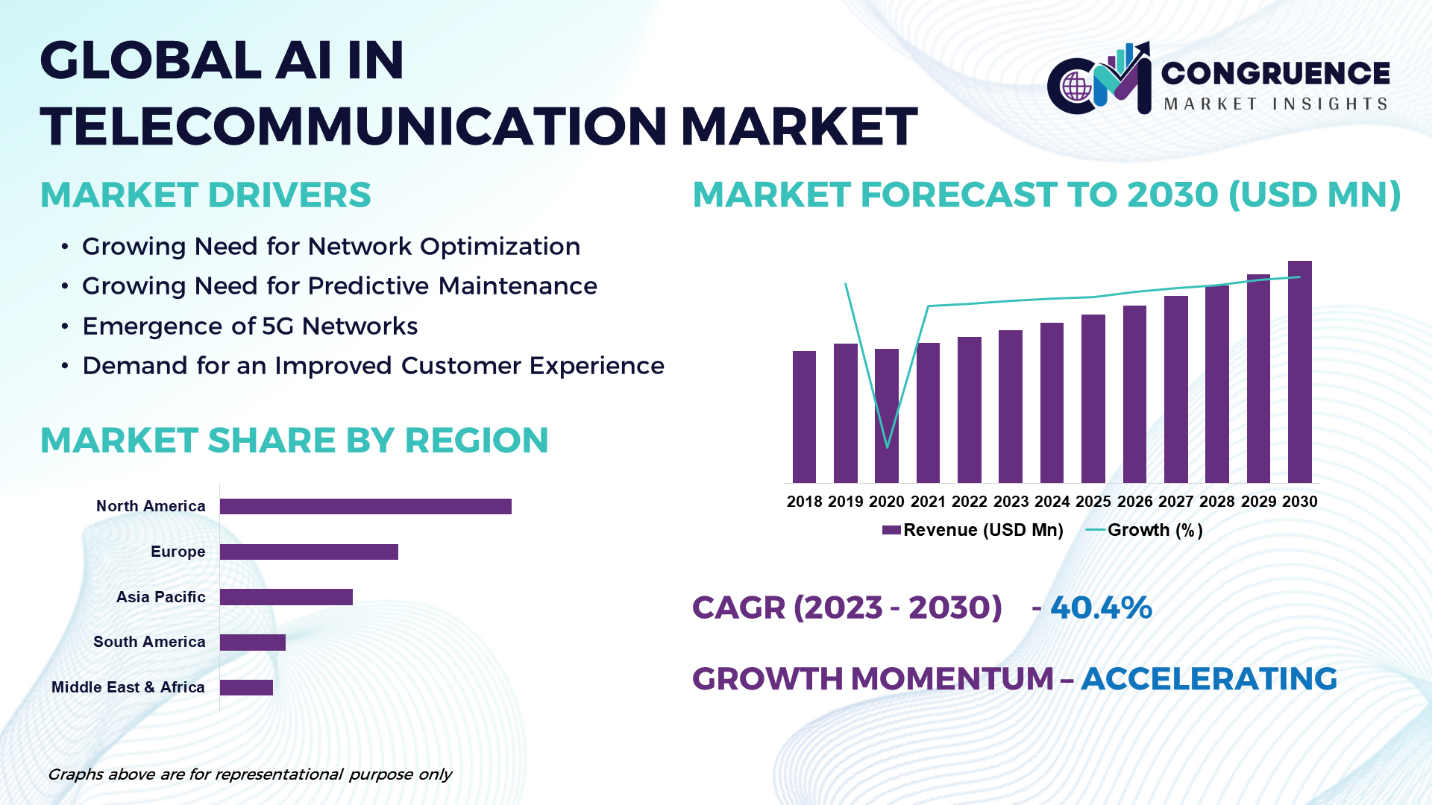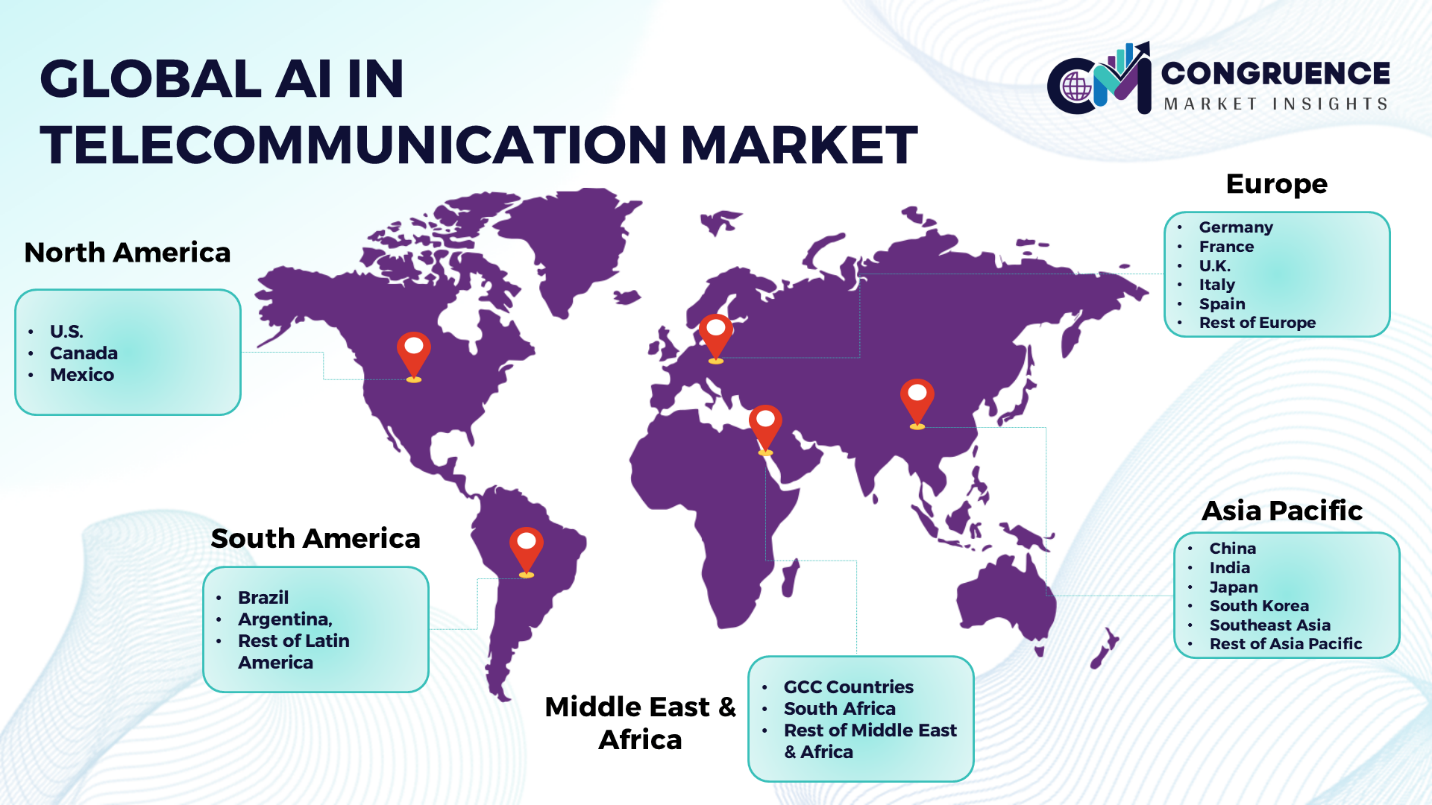Reports
The Global AI in Telecommunication Market is expected to expand at a CAGR of 40.4% between 2023 and 2030. The merging of artificial intelligence (AI) technology with the telecommunications sector is reflected in the global AI in Telecommunications market, which is transforming the management, operation, and optimization of communication networks. Telecommunication networks are using AI-powered solutions more frequently in order to improve performance, efficiency, and user experience. Numerous functions are covered by AI applications in telecommunications, such as cybersecurity, network management and optimization, predictive maintenance, automated customer support, and targeted marketing. Artificial Intelligence (AI) empowers telecommunication operators to automate repetitive processes, derive meaningful insights from massive volumes of data, and provide proactive services to clients through sophisticated analytics, machine learning algorithms, and natural language processing capabilities. Telecom companies are using AI to lower operating costs, enhance service quality, and optimize network infrastructure. Real-time monitoring, predictive analytics, and automatic troubleshooting are made possible by AI-driven network management systems, which guarantee optimal network performance and dependability. Predictive maintenance enabled by AI also reduces downtime and service interruptions by assisting in the early detection and resolution of possible network problems.

AI in Telecommunication Market Major Driving Forces
Growing Need for Network Optimization: The demand for advanced AI solutions for network optimization, capacity planning, and resource allocation is being driven by the growing complexity of telecommunication networks and the spike in data traffic.
Growing Need for Predictive Maintenance: In order to minimize network outages, improve service dependability, and optimize maintenance schedules, telecommunication companies are implementing AI-driven predictive maintenance solutions, which is fueling market demand.
Emergence of 5G Networks: The use of AI in telecommunications infrastructure is being driven by the need for complex AI algorithms to control network congestion, guarantee quality of service (QoS), and provide low-latency connectivity.
Demand for an Improved Customer Experience: Telecom firms can now offer individualized services, proactive assistance, and customized recommendations to their customers, increasing customer happiness and loyalty, thanks to AI-powered chatbots, virtual assistants, and predictive analytics.
AI in Telecommunication Market Key Opportunities
Deployment of 5G Networks: To fully realize the potential of high-speed, low-latency connectivity, the introduction of 5G networks offers substantial prospects for AI-driven solutions in the telecommunications industry, such as network optimization, quality of service (QoS) management, and edge computing.
IoT Ecosystem Expansion: As Internet of Things (IoT) devices and related services proliferate, there is a growing need for AI-enabled telecom solutions. These include IoT device management, data analytics, and predictive maintenance, which can help to support the development of smart cities, industries, and applications.
Enhanced Customer Engagement: By enabling telecom companies to provide smooth, proactive customer experiences, AI-powered chatbots, virtual assistants, and personalized recommendations open up new opportunities for the use of AI in churn prediction, personalized marketing, and customer service automation.
AI in Telecommunication Market Key Trends
· Integrating chatbots and virtual assistants powered by AI to improve customer service.
· Adoption of predictive maintenance and network optimization tools driven by AI.
· Expansion of AI's use in cybersecurity to detect and respond to threats.
· Using AI to target promotions and provide individualized marketing.
· Rise of analytics solutions powered by AI for data-driven decision-making.
· AI technology integration to facilitate 5G network deployment.
· AI-enabled edge computing and mobile edge computing (MEC) are receiving more attention.
· Working together, technology suppliers and telecom carriers can promote innovation in AI.
· Adoption of governance and compliance monitoring systems powered by AI.
· Application of AI to software-defined networking (SDN) optimization and network orchestration.

Market Competition Landscape
The competitive landscape of the global AI in Telecommunication market is characterized by intense competition among a diverse array of players, including telecommunication operators, technology companies, AI solution providers, and startups. Established telecommunication giants such as AT&T, Verizon, and Vodafone are investing heavily in AI technologies to gain a competitive edge in network management, customer service, and cybersecurity. Concurrently, leading technology firms such as IBM, Microsoft, and Google are developing AI-driven solutions tailored for telecommunication use cases, leveraging their expertise in artificial intelligence, cloud computing, and data analytics. Additionally, a burgeoning ecosystem of AI startups and niche players is emerging, offering specialized AI solutions for network optimization, predictive maintenance, and customer engagement. Moreover, partnerships and collaborations between telecommunication operators, technology vendors, and AI startups are increasingly common, facilitating innovation, knowledge sharing, and market expansion. As the demand for AI in telecommunication continues to grow, the competitive landscape is expected to evolve further, with players vying for market share through innovation, strategic alliances, and differentiation in AI capabilities and offerings. Prominent players in the market include:
· AT&T Inc.
· Verizon Communications Inc.
· Vodafone Group Plc
· IBM Corporation
· Microsoft Corporation
· Google LLC
· Huawei Technologies Co., Ltd.
· Cisco Systems, Inc.
· Nokia Corporation
· Ericsson AB
· Accenture plc
· Amazon Web Services, Inc.
· Intel Corporation
· Qualcomm Incorporated
· Oracle Corporation
|
Report Attribute/Metric |
Details |
|
Base Year |
2022 |
|
Forecast Period |
2023 – 2030 |
|
Historical Data |
2018 to 2022 |
|
Forecast Unit |
Value (US$ Mn) |
|
Key Report Deliverable |
Revenue Forecast, Growth Trends, Market Dynamics, Segmental Overview, Regional and Country-wise Analysis, Competition Landscape |
|
Segments Covered |
· By Component (Solutions, Services) · By Deployment Mode (Cloud-based, On-premises) · By Application (Network Management, Customer Service, Predictive Analytics, Cybersecurity, Others) · By End-user (Telecommunication Operators, Enterprises) |
|
Geographies Covered |
North America: U.S., Canada and Mexico Europe: Germany, France, U.K., Italy, Spain, and Rest of Europe Asia Pacific: China, India, Japan, South Korea, Southeast Asia, and Rest of Asia Pacific South America: Brazil, Argentina, and Rest of Latin America Middle East & Africa: GCC Countries, South Africa, and Rest of Middle East & Africa |
|
Key Players Analyzed |
AT&T Inc., Verizon Communications Inc., Vodafone Group Plc, IBM Corporation, Microsoft Corporation, Google LLC, Huawei Technologies Co., Ltd., Cisco Systems, Inc., Nokia Corporation, Ericsson AB, Accenture plc, Amazon Web Services, Inc., Intel Corporation, Qualcomm Incorporated, Oracle Corporation |
|
Customization & Pricing |
Available on Request (10% Customization is Free) |
